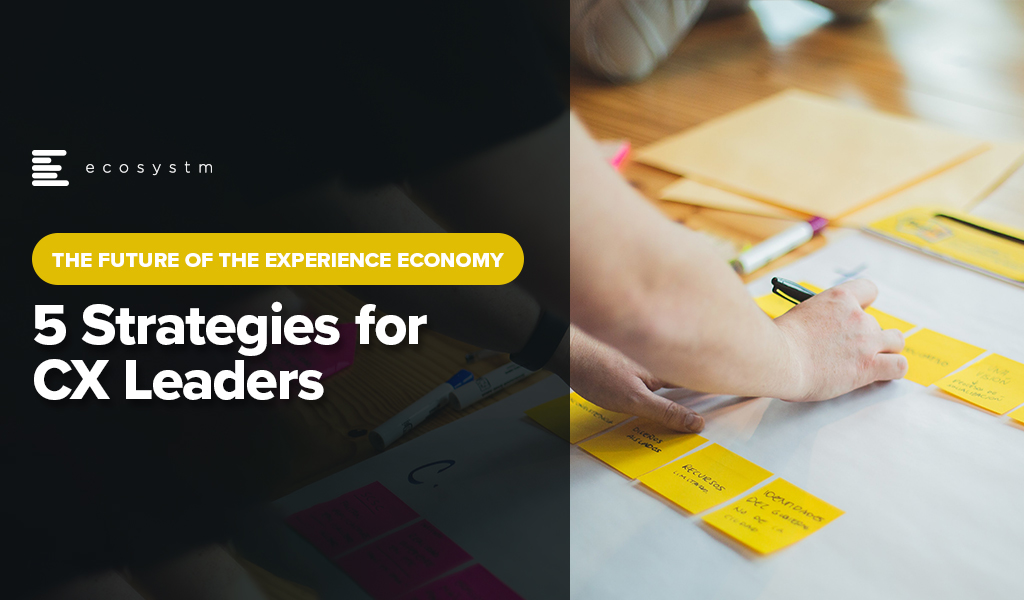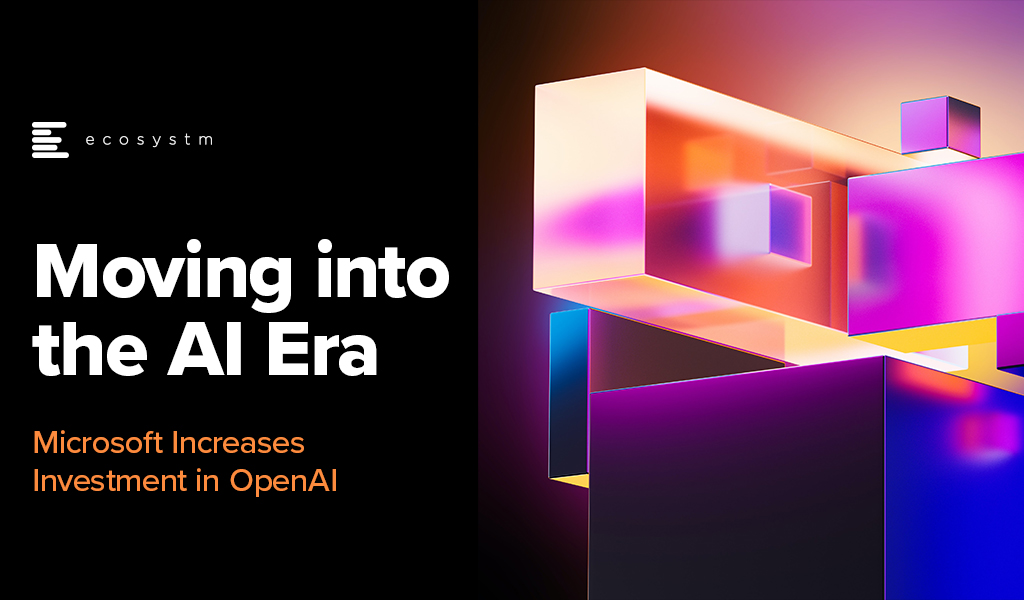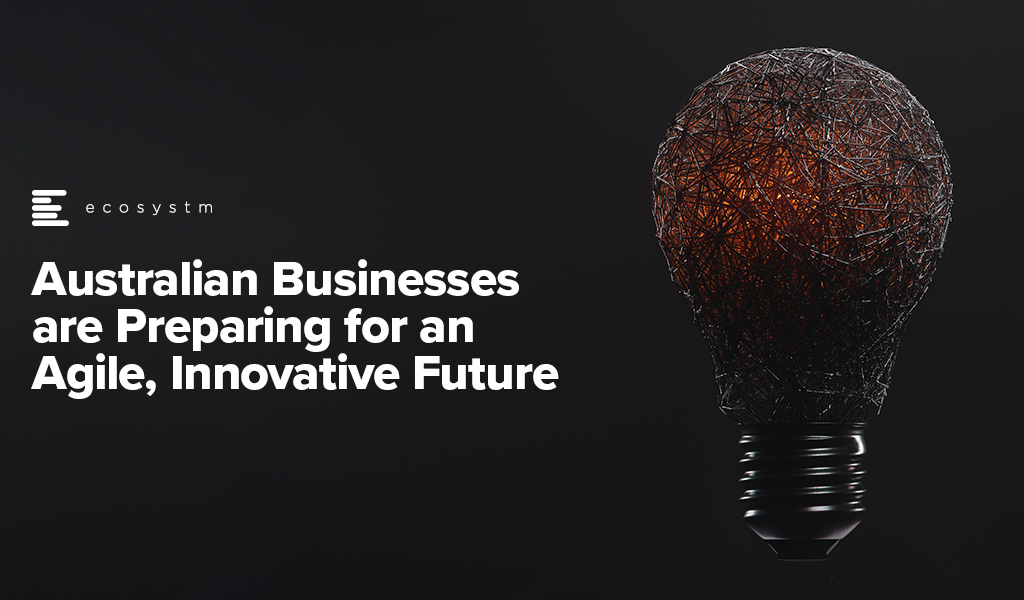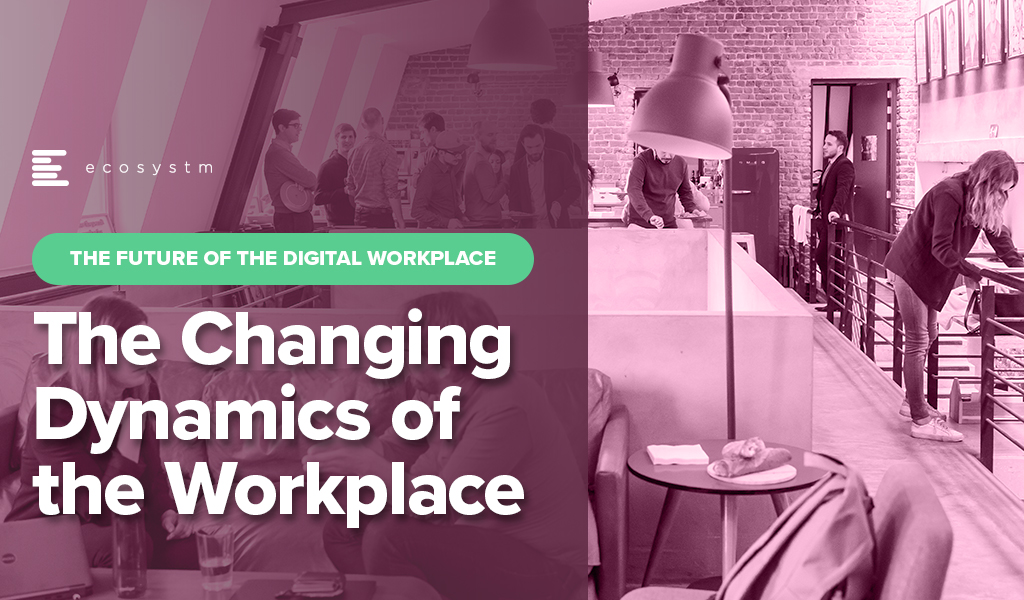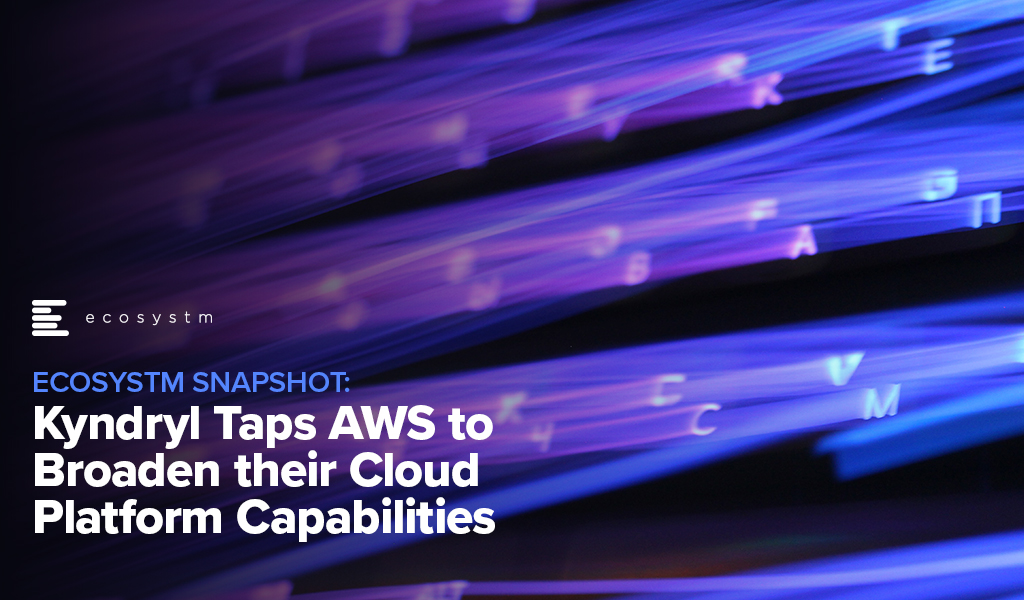In my last Ecosystm Insight, I spoke about the 5 strategies that leading CX leaders follow to stay ahead of the curve. Data is at the core of these CX strategies. But a customer data breach can have an enormous financial and reputational impact on a brand.
Here are 12 essential steps to effective governance that will help you unlock the power of customer data.
- Understand data protection laws and regulations
- Create a data governance framework
- Establish data privacy and security policies
- Implement data minimisation
- Ensure data accuracy
- Obtain explicit consent
- Mask, anonymise and pseudonymise data
- Implement strong access controls
- Train employees
- Conduct risk assessments and audits
- Develop a data breach response plan
- Monitor and review
Read on to find out more.
Download ‘A 12-Step Plan for Governance of Customer Data’ as a PDF

In good times and in bad, a great customer experience (CX) differentiates your company from your competitors and creates happy customers who turn into brand advocates. While some organisations in Asia Pacific are just starting out on their CX journey, many have made deep investments. But in the fast-paced world of digital, physical and omnichannel experience improvement, if you stand still, you fall behind.
We interviewed CX leaders across the region, and here are the top 5 top actions that they are taking to stay ahead of the curve.
#1 Better Governance of Customer Data
Most businesses accelerate their CX journeys by collecting and analysing data. They copy data from one channel to another, share data across touchpoints, create data silos to better understand data, and attempt to create a single view of the customer. Without effective governance, every time create copies of customer data are created, moved, and shared with partners, it increases the attack surface of the business. And there is nothing worse than telling customers that their data was accessed, stolen or compromised – and that they need to get a new credit card, driver’s license or passport.
To govern customer data effectively, it is essential to collaborate with different stakeholders, such as legal, risk, IT, and CX leaders – data owners, consumers, and managers, analytics leaders, data owners, and data managers – in the strategy discussions.
#2 Creating Human Experiences
To create a human-centric experience, it is important to understand what humans want. However, given that each brand has different values, the expectations of customers may not always be consistent.
Much of the investment in CX by Asian companies over the past five years have been focused on making transactions easy and effective – but ultimately it is the emotional attachment which brings customers back repeatedly. In creating human experiences, brands create a brand voice that is authentic, relatable, empathetic and is consistent across all channels.
Humanising the experience and brand requires:
- Hyperpersonalisation of customer interactions. By efforts such as using names, understanding location requirements, remembering past purchases, and providing tailored recommendations based on their expectations, businesses can make customers feel valued and understood. Understanding the weather, knowing whether the customer’s favourite team won or lost on the weekend, mentioning an important birthday, etc. can all drive real, human experiences – with or without an actual human involved in the process!
- Transparency. Honesty and transparency can go a long way in building trust with customers. Businesses should be open about their processes, pricing, and policies. Organisations should be transparent about mistakes and what they are doing to fix the problem.
#3 Building Co-creation Opportunities
Co-creation is a collaborative approach where organisations involve their customers in the development and improvement of products, services, and experiences. This process can foster innovation, enhance customer satisfaction, and contribute to long-term business success. Co-creation can increase customer satisfaction and loyalty, drive innovation, enhance brand reputation, boost market relevance, and reduce risks and costs.
Strategies for co-creation include:
- Creating open innovation platforms where customers can submit ideas, feedback, and suggestions
- Organising workshops or focus groups that bring together customers, designers, and developers to brainstorm and generate new ideas
- Running contests or crowdsourcing initiatives to engage customers in problem-solving and idea generation
- Establishing feedback loops and engaging customers in the iterative development process
- Partnering with customers or external stakeholders, such as suppliers or distributors, to co-create new products or services
#4 Collecting Data – But Telling Stories
Organisations use storytelling as a powerful CX tool to connect with their customers, convey their brand values, and build trust.
Here are some ways organisations share stories with their customers:
- Brand storytelling. Creating narratives around their brand that showcase their mission, vision, and values
- Customer testimonials and case studies. Sharing real-life experiences of satisfied customers to showcase the value of a product or service
- Content marketing. Creating engaging content in the form of blog posts, articles, videos, podcasts, and more to educate, entertain, and inform their customers
- Social media. Posting photos, videos, or updates that showcase the brand’s personality, to strengthen relationships with the audience
- Packaging and in-store experiences. Creative packaging and well-designed in-store experiences to tell a brand story and create memorable customer interactions
- Corporate social responsibility (CSR) initiatives. Helping customers understand the values the organisation stands for and build trust
#5 Finally – Not Telling Just Positive Stories!
Many companies focus on telling the good stories: “Here’s what happens when you use our products”; “Our customers are super-successful” and; “Don’t just take it from us, listen to what our customers say.”
But memorable stories are created with contrast – like telling the story of what happened when someone didn’t use the product or service. Successful brands don’t want to just leave the audience with a vision of what could be possible, but also what will be likely if they don’t invest. Advertisers have understood this for years, but customers don’t just hear stories through advertisements – they hear it through social media, word of mouth, traditional media, and from sales and account executives.

Microsoft’s intention to invest a further USD 10B in OpenAI – the owner of ChatGPT and Dall-E2 confirms what we said in the Ecosystm Predicts – Cloud will be replaced by AI as the right transformation goal. Microsoft has already invested an estimated USD 3B in the company since 2019. Let’s take a look at what this means to the tech industry.
Implications for OpenAI & Microsoft
OpenAI’s tools – such as ChatGPT and the image engine Dell-E2 – require significant processing power to operate, particularly as they move beyond beta programs and offer services at scale. In a single week in December, the company moved past 1 million users for ChatGPT alone. The company must be burning through cash at a significant rate. This means they need significant funding to keep the lights on, particularly as the capability of the product continues to improve and the amount of data, images and content it trawls continues to expand. ChatGPT is being talked about as one of the most revolutionary tech capabilities of the decade – but it will be all for nothing if the company doesn’t have the resources to continue to operate!
This is huge for Microsoft! Much has already been discussed about the opportunity for Microsoft to compete with Google more effectively for search-related advertising dollars. But every product and service that Microsoft develops can be enriched and improved by ChatGPT:
- A spreadsheet tool that automatically categorises data and extract insight
- A word processing tool that creates content automatically
- A CRM that creates custom offers for every individual customer based on their current circumstances
- A collaboration tool that gets answers to questions before they are even asked and acts on the insights and analytics that it needs to drive the right customer and business outcomes
- A presentation tool that creates slides with compelling storylines based on the needs of specific audiences
- LinkedIn providing the insights users need to achieve their outcomes
- A cloud-based AI engine that can be embedded into any process or application through a simple API call (this already exists!)
How Microsoft chooses to monetise these opportunities is up to the company – but the investment certainly puts Microsoft in the box seat to monetise the AI services through their own products while also taking a cut from other ways that OpenAI monetises their services.
Impact on Microsoft’s competitors
Microsoft’s investment in OpenAI will accelerate the rate of AI development and adoption. As we move into the AI era, everything will change. New business opportunities will emerge, and traditional ones will disappear. Markets will be created and destroyed. Microsoft’s investment is an attempt for the company to end up on the right side of this equation. But the other existing (and yet to be created) AI businesses won’t just give up. The Microsoft investment will create a greater urgency for Google, Apple, and others to accelerate their AI capabilities and investments. And we will see investments in OpenAI’s competitors, such as Stability AI (which raised USD 101M in October 2022).
What will change for enterprises?
Too many businesses have put “the cloud” at the centre of their transformation strategies – as if being in the cloud is an achievement in itself. While cloud made applications and processes are easier to transform (and sometimes cheaper to deploy and run), for many businesses, they have just modernised their legacy end-to-end business processes on a better platform. True transformation happens when businesses realise that their processes only existed because they of lack of human or technology capacity to treat every customer and employee as an individual, to determine their specific needs and to deliver a custom solution for them. Not to mention the huge cost of creating unique processes for every customer! But AI does this.
AI engines have the ability to make businesses completely rethink their entire application stack. They have the ability to deliver unique outcomes for every customer. Businesses need to have AI as their transformation goal – where they put intelligence at the centre of every transformation, they will make different decisions and drive better customer and business outcomes. But once again, delivering this will take significant processing power and access to huge amounts of content and data.
The Burning Question: Who owns the outcome of AI?
In the end, ChatGPT only knows what it knows – and the content that it learns from is likely to have been created by someone (ideally – as we don’t want AI to learn from bad AI!). What we don’t really understand is the unintended consequences of commercialising AI. Will content creators be less willing to share their content? Will we see the emergence of many more walled content gardens? Will blockchain and even NFTs emerge as a way of protecting and proving origin? Will legislation protect content creators or AI engines? If everyone is using AI to create content, will all content start to look more similar (as this will be the stage that the AI is learning from content created by AI)? And perhaps the biggest question of all – where does the human stop and the machine start?
These questions will need answers and they are not going to be answered in advance. Whatever the answers might be, we are definitely at the beginning of the next big shift in human-technology relations. Microsoft wants to accelerate this shift. As a technology analyst, 2023 just got a lot more interesting!

In recent years, businesses have faced significant disruptions. Organisations are challenged on multiple fronts – such as the continuing supply chain disruptions; an ongoing energy crisis that has led to a strong focus on sustainability; economic uncertainty; skills shortage; and increased competition from digitally native businesses. The challenge today is to build intelligent, data-driven, and agile businesses that can respond to the many changes that lie ahead.
Leading organisations are evaluating ways to empower the entire business with data, machine learning, automation, and AI to build agile, innovative, and customer-focused businesses.
Here are 7 steps that will help you deliver business value with data and AI:
- Understand the problems that need solutions. Before an organisation sets out on its data, automation, and AI journey, it is important to evaluate what it wants to achieve. This requires an engagement with the Tech/Data Teams to discuss the challenges it is trying to resolve.
- Map out a data strategy framework. Perhaps the most important part of this strategy are the data governance principles – or a new automated governance to enforce policies and rules automatically and consistently across data on any cloud.
- Industrialise data management & AI technologies. The cumulation of many smart, data-driven initiatives will ultimately see the need for a unified enterprise approach to data management, AI, and automation.
- Recognise the skills gap – and start closing it today. There is a real skills gap when it comes to the ability to identify and solve data-centric issues. Many businesses today turn to technology and business consultants and system integrators to help them solve the skills challenge.
- Re-start the data journey with a pilot. Real-world pilots help generate data and insights to build a business case to scale capabilities.
- Automate the outcomes. Modern applications have made it easier to automate actions based on insights. APIs let systems integrate with each other, share data, and trigger processes; and RPA helps businesses automate across applications and platforms.
- Learn and improve. Intelligent automation tools and adaptive AI/machine learning solutions exist today. What organisations need to do is to apply the learnings for continuous improvements.
Find more insights below.
Download The Future of Business: 7 Steps to Delivering Business Value with Data & AI as a PDF

If you have been following my insights and blogs at Ecosystm, it won’t come as a surprise that I am a fan of foldable devices. I have owned the Z Fold3 for over a year now. In that year, I found myself reaching for my tablet less often as the larger screen on the Z Fold3 was enough for most of my needs. Most apps were resized appropriately and provided an improved user experience, and the upgraded OS with a MacOS style application bar made it even easier to switch between applications.
The larger screen of the foldable form factor boosted my productivity too – I could use multiple applications and respond to an email with the content’s source (PDF, Excel file, website, etc.) also open – meaning far less flicking between apps, which isn’t as easy on a smartphone compared to a laptop or a desktop computer. The computer style view for messages and emails (with the email list on the left and the actual email on the right) was brilliant. And I enjoyed using the external screen as a preview screen for taking selfies (I already have my work cut out in making selfies look good! So, being able to see the picture in advance helps a lot).
However, Fold3 had its imperfections. The slightly narrow front screen made typing difficult when the device was folded – I primarily used it to check the status of things (such as turning my coffee machine on/off, checking my solar production, etc.). The inside screen also had durability issues. After a year, Samsung installed screen protector was coming off, and then, the right inner screen gave up completely on me. That said, Samsung has been excellent at fixing these issues under warranty.
Samsung Galaxy Z Fold4 – Enhanced Features
With the launch of the new Z Fold4, I was keen to get my hands on a trial device, and the good people at Samsung and their PR agency arranged that for me. I have now spent two weeks with this device. Despite it being similar in size to the Z Fold3, the upgrades do make a real difference:
- The few extra mm of width on the front screen makes it much more usable – I can now use this screen for typing messages and entering data. I still prefer the larger screen for things such as consuming content and typing longer emails. But the outside screen is usable for more than just checking the status of systems or apps.
- The shorter height and the wider screen mean that the inside screen now feels more “expansive” – more of a tablet experience – and is getting closer to an iPad mini. This makes consuming and creating content easier and more enjoyable. As an avid tablet user, even with the Z Fold3, I would hesitate when going out, wondering if I needed to take my iPad with me. I noticed that I did not hesitate with the Z Fold4 – I was fine without my tablet.
- Typically, newer phones feature improved cameras. This is certainly the case with the Z Fold4 – the camera feels faster than the Fold3, taking lesser time to focus and take pictures. And the images too are sharper and richer.
- The screen warranty has also improved – perhaps in acknowledgement of the issues with the Z Fold3 screen. There are specials offering screen replacements for a low cost, even if you damage the screen, as well as discounts on Samsung Care+, which offers two replacement devices in 24 months.
The only comment I have is that it is the most slippery phone I have used so far! It didn’t come with a protective case and in two weeks, I have dropped this phone more times than I have dropped any other phone in the past few years! It has slipped off seats and desks as well as out of my pocket and hands. Although, it does claim to “stand up to life’s bumps and fumbles” and this has been accurate so far (as it does not even have a scratch on it yet – which is a surprise as it has hit wood, tiles, and concrete pretty hard!). But if I were keeping the device for any longer, I would immediately purchase a case!
Who Will Use It Most?
Whether this device is right for you depends on your device use patterns. I do believe there is a case for businesses to invest in foldables – particularly for employees who share content one on one with clients or prospects, or those who want to be more productive and be away from their desks without lugging a laptop. Anyone who is considering a flagship phone with a larger screen (iPhone Pro Max or Pixel 7 Pro) should take a look at the Samsung Galaxy Z Fold4. You will be pleasantly surprised with the quality and capability of this device. I know I will be sad to see it go when I hand it back to Samsung!

Businesses in Australia have come a long way over the past few years in digitising their processes and capabilities. In early 2020 – as the pandemic swept across the globe – nearly every business began to understand the challenges that lay ahead in digitising their organisation to meet the needs of fully remote employees and customers. Teams all across the business started to plug holes, reshape processes and deploy new technology capabilities to quickly meet these changing needs. This work continued over the next few years to the point now that most businesses in Australia have fully digital front-ends.
But as businesses move to “COVID normal” they are looking to the next opportunity. Digitising existing processes isn’t enough – they are starting to accelerate their innovation to create entirely new digitally native products and services. Growth by selling more of what they make is being replaced by a desire to grow into new markets, new products and new services. Business innovation has leapt back onto the agenda – and the ability to innovate at pace will define success in this new era.
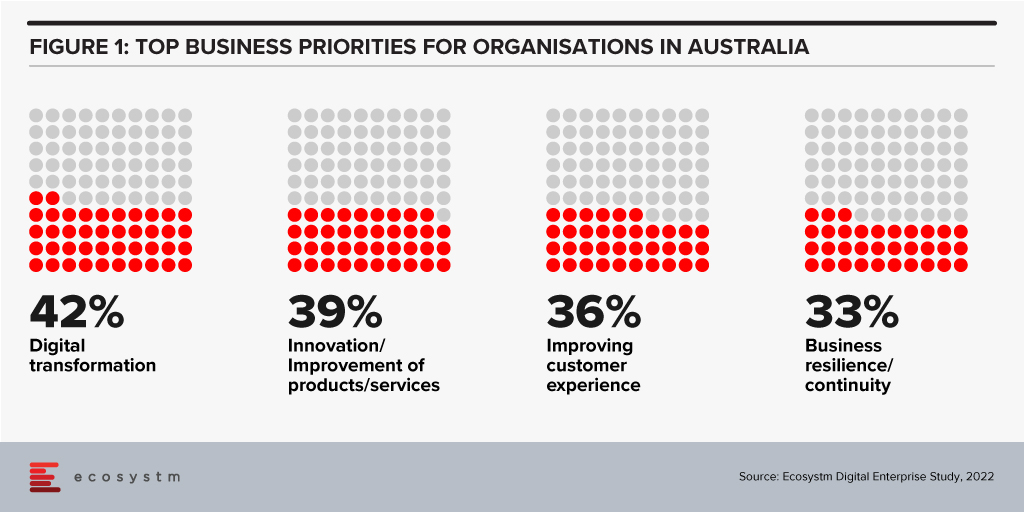
Improving IT Operations is a Major Priority for Tech Leaders in Australia
At the same time, technology leaders and their teams are dealing with technical debt and process complexity brought on by two years of accelerated and unplanned technology implementations. There is an urgent need to modernise IT Operations to better manage the growing number and complexity of digital systems. With the increasing importance of digital services to business, the Service Management and Tech Operations functions need increased investment, better processes, and greater automation to find and fix technology issues to minimise the impact of these issues on customer and employee outages.
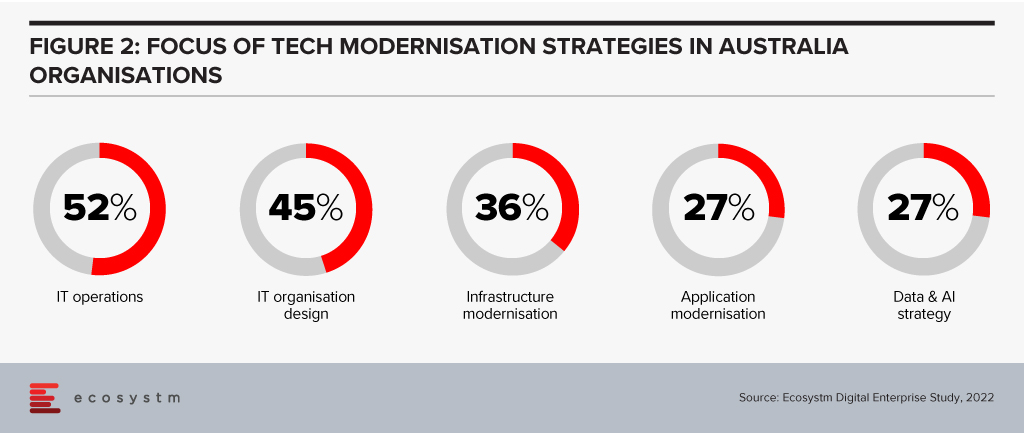
The Skills Crisis is Real – and Not Going Away Soon
The challenge today is to drive this important change while faced with the tech skills shortage. IT has not been spared the struggles that come with a low unemployment market – but often many of the Employee Experience initiatives designed to improve employee retention and loyalty are not designed with the tech team in mind. The demand for tech skills is from the lowest to the highest levels – from level 1 helpdesk operators to security, coding, cloud, and system management professionals – tech leaders are finding it very difficult to find and keep good staff.
Hybrid Cloud is Gaining Traction in Australia
As tech leaders design the technology team and architecture that will help to drive their business forward and enable the agile, innovative future that the business leaders imagine, it is becoming clear that the hybrid cloud will play an increasingly important role in this future. While the drive to public cloud is real – there is an increasing recognition that some applications will remain in private cloud environments and therefore they need to manage a multi-cloud world. Australian businesses have embraced hybrid cloud management platforms to manage their many cloud investments – both public and private – and help the business deliver new digital services at pace.
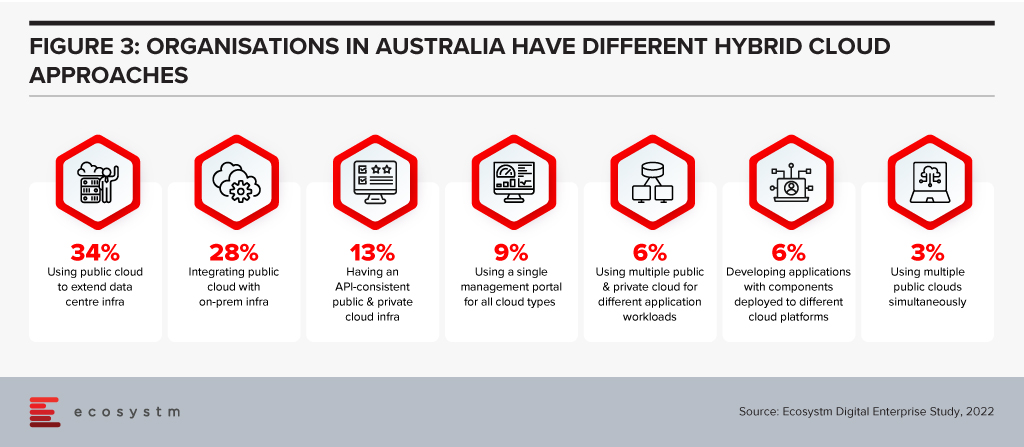
Tech Leaders Need to Perform a Balancing Act
The need to deploy new digital services, continuously improve them, make them always available, ensure they are running in the best environment, deliver automation and AI initiatives using great data – while finding and keeping the skills the tech team needs – are the real challenges that IT leaders face today. Finding the right balance between investment, automation, skills, governance, security, speed and agility (amongst many other factors) is the never-ending job of the CIO – it is just more crucial than ever that they get this right, as the ability of the business to survive and thrive in this new era of innovation and agility is at stake.

The last few months have been full of bad news for some of the organisations currently recognised as the most innovative firms on the planet. Netflix has been losing subscribers, Amazon’s revenue growth is slowing dramatically, and Tesla now has serious competition in the EV market, with its dominance beginning to wane. In Australia – my home country – some of the “fintech” banks have closed their virtual doors over the past six months, leaving the market to the traditional players.
And many of the traditional businesses are turning themselves around. Foxtel, the “legacy” cable TV provider in Australia, has grown its subscriber base by 19% off the back of its streaming services – where subscriber numbers are growing at over 60% YoY. ComfortDelgro – a transport provider based out of Singapore – is seeing its revenue start to increase again after being hit hard by digital competitors and the pandemic. CBA’s “Ceba” virtual assistant is winning plaudits in Australia and globally.
It’s Not Too Late to Catch-up!
In many respects, the fact that the digital disruptors got SO far ahead is an indication of just how slow the rest of the market was to respond, and a credit to the significant investments these innovators made to get ahead. But now that the rest of the market is catching up shows that there is no secret sauce when it comes to innovation. What Uber, Tesla, Amazon and every other digital innovator has done is replicable. Your business just needs to make the necessary changes to give you the ability to catch up to the digital innovators in your industry – do it well and you will even keep up with them or get ahead. And innovation is the leading business priority for most organisations today!
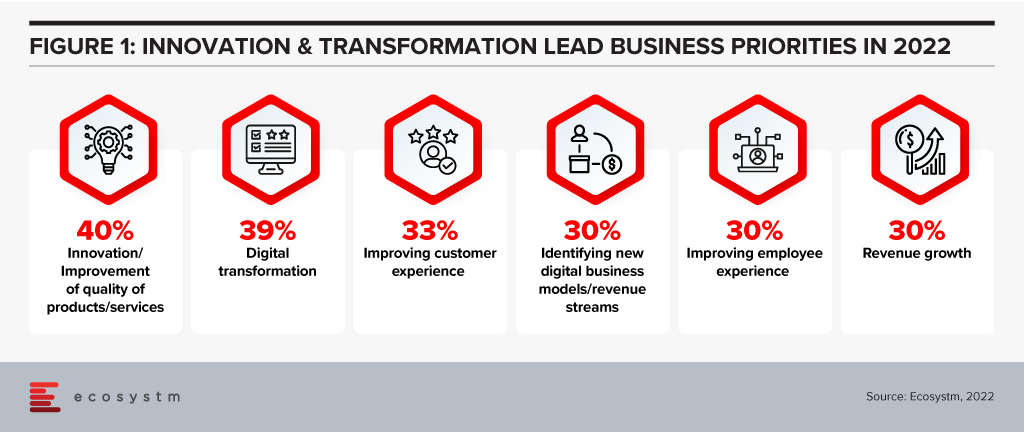
What all of the digital disruptors did fifteen years ago, and many other businesses have done since then, is develop the ability to create and improve digital customer experiences at pace. Nearly every customer experience is digital – at least in part. So creating great digital experiences will go a long way to creating great customer experiences. Sounds easy right?
However, what this actually means is they changed their culture, structure, KPIs, technology, skills and the nature of their business. Many organisations have beaten the path to becoming digital businesses – in fact, it is a well-worn path. When you set off on the journey you are no longer taking risks or heading out alone. There is a very clear playbook as to how to become a digital business today.
What Does a Digital Business Look Like?
If you are part of your organisation’s tech team and wondering how digital your business is, ask these questions:
- Do you mainly deploy new technology services with the Waterfall project methodology?
- Do all of the development work with the IT team (and not in business or customer teams)?
- Does it take months or years to deploy new services?
- Are your KPIs the same as they were 5-10 years ago?
If the answer to some or all of these questions is YES, then it is likely that you are working for a business that will not catch up with or get ahead of your competitors. You might have a few initiatives that see you make some ground on them – but innovation today is not about leaps and bounds – it is about continual improvement. If you catch up today but don’t have the ability to continually improve, you will have fallen behind again tomorrow…
The good news is it is never too late to start this journey. It typically starts from the top of your business – the CIO cannot make the entire business agile. The head of the digital cannot change the culture of the entire organisation. But the IT and digital teams can get the ball rolling by changing their structure and work processes. Start by moving some developers into the Customer Experience team (if you have one!). Stop funding projects and start funding squads, tribes and teams. Structure the team around the customer journey – or at least make it easier for customers to get value from the digital assets and services you offer. Hopefully, someone will notice the fact that the tech team is helping a business unit or team to operate with agility and they’ll start asking why they cannot have that same ability?
And by then the ball is rolling down the hill and you are on your way to being a digital business – and on your way to giving customers the products, services and experiences they demand today and tomorrow.

The way we work in Australia and New Zealand (ANZ) is changing. In 2020 “work” went from a place you go to something you do.
Through the many restrictions in 2020 and 2021, knowledge workers in ANZ changed their work behaviours and employers changed their expectations of their employees. Tighter border controls and fast economic recoveries have swung the pendulum in the favour of employees, and “The Great Resignation” has started to play out across the region.
The Ecosystm Voice of the Employee Study aims to explore the emerging global Future of Work trends from an employee’s point-of-view. In an environment of uncertainty, this study is designed to be an ongoing, dynamic study that will be able to track the major shifts in preferences, perceptions, and practices through 2022.
Here are some insights from the study that can help businesses in ANZ develop strategies and capabilities to better serve their remote and office-based employees.
- The Great Resignation has begun in ANZ
- Women are more likely to work entirely from home
- Those working entirely from home are more likely to change jobs/careers in 2022
- Knowledge workers in ANZ are enjoying the Work from Home model
- Employees are looking for more flexibility and choice
Read on to find out more.

Last week, Kyndryl became a Premier Global Alliance Partner for AWS. This follows other recent similar partnerships for Kyndryl with Google and Microsoft. This now gives Kyndryl premier or similar partner status at the big three hyperscalers.
The Partnership
This new partnership was essential for Kyndryl to provide legitimacy to their independent reputation and their global presence. And in many respects, it is a partnership that AWS needs as much as Kyndryl does. As one of the largest global managed services providers, Kyndryl manages a huge amount of infrastructure and thousands of applications. Today, most of these applications sit outside public cloud environments, but at some stage in the future, many of these applications will move to the public cloud. AWS has positioned itself to benefit from this transition – as Kyndryl will be advising clients on which cloud environment best suits their needs, and in many cases Kyndryl will also be running the application migration and managing the application when it resides in the cloud. To that end, the further investment in developing an accelerator for VMware Cloud on AWS will also help to differentiate Kyndryl on AWS. With a high proportion of Kyndryl customers running VMware, this capability will help VMware users to migrate these workloads to the cloud and run core businesses services on AWS.
The Future
Beyond the typical partnership activities, Kyndryl will build out its own internal infrastructure in the cloud, leveraging AWS as its preferred cloud provider. This experience will mean that Kyndryl “drinks its own champagne” – many other managed services providers have not yet taken the majority of their infrastructure to the cloud, so this experience will help to set Kyndryl apart from their competitors, along with providing deep learning and best practices.
By the end of 2022, Kyndryl expects to have trained more than 10,000 professionals on AWS. Assuming the company hits these targets, they will be one of AWS’s largest partners. However, experience trumps training, and their relatively recent entry into the broader cloud ecosystem space (after coming out from under IBM’s wing at the end of 2021) means they have some way to go to have the depth and breadth of experience that other Premier Alliance Partners have today.
Ecosystm Opinion
In my recent interactions with Kyndryl, what sets them apart is the fact that they are completely customer-focused. They start with a client problem and find the best solution for that problem. Yes – some of the “best solutions” will be partner specific (such as SAP on Azure, VMware on AWS), but they aren’t pushing every customer down a specific path. They are not just an AWS partner – where every solution to every problem starts and ends with AWS. The importance of this new partnership is it expands the capabilities of Kyndryl and hence expands the possibilities and opportunities for Kyndryl clients to benefit from the best solutions in the market – regardless of whether they are on-premises or in one of the big three hyperscalers.














